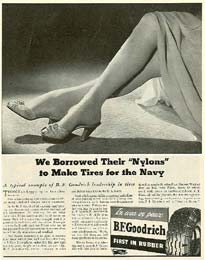
By Carl Zebrowski
For a woman of the 1940s, stockings were just as essential to dressing up as a dress. Sheer hosiery enhanced the appearance of the leg and provided a neat, finished look to outfits for wear at the office, at church, or for dinner out.
Silk was the preferred material for stockings, because of its luxurious look and feel. But silk stockings were expensive and anything but durable. Women sometimes opted for cotton and wool, but those didn’t look dressy. Stockings created from manmade rayon were another possibility, but they didn’t fit well, tending to sag and form “knees” of their own that didn’t line up for long with those of the wearer. Women needed a better alternative.
Science came to the rescue. The chemical company DuPont launched an effort to produce synthetic silk in the 1920s. Working with a team of scientists for a decade, Julian Hill pulled a heated rod out of a solution of coal tar, water, and alcohol one day to find a sheer filament stretched between the rod and the solution. At room temperature, the filament looked and felt like silk. The new material made its debut at the 1939 New York World’s Fair as “nylon,” from the abbreviation NY.
Nylon first hit the market as toothbrush bristles, fishing line, and surgical stitching. But on May 15, 1940, nylon stockings hit the shelves of New York City. By the end of the day, some 780,000 pairs had been sold. Soon the material and the hosiery made from it were synonymous, and stockings, regardless of what they were made of, became “nylons.”
Because nylon didn’t stretch, the original nylons had to be manufactured in numerous different sizes. The material was knitted flat in various shapes and lengths and then sewn at the back so a finished stocking more or less followed the form of the leg—narrower above and below the calf and wider at the thigh. The tailoring was known as “fully fashioned” (not to be confused with well fitting).
By the end of 1940, 64 million pairs of nylons had been sold. But before the next year ended, war came, and the three most common sheer stocking materials—silk, nylon, and rayon—were all but lost to the war effort. Much of what little silk was available to the United States was used to make powder sacks for the military, because it left no residue inside gun barrels. “When anyone got word that the local Five and Dime store had received a shipment [of silk stockings], lines would form through the store and around the block,” Mary E. Mazzei of Cleveland, Ohio, wrote at hbo.com. Nylon was most useful to the military, going into parachutes, tents, ropes, and tires. Known as the “miracle fiber,” it was so critical to the war effort that drives were held to collect worn-out nylons to be recycled for military use. Rayon had some of the same military uses as nylon, yet it remained the most widely available type of sheer stocking.
One solution to the stocking shortage was for women simply to wear cotton socks. The socks were short and worn folded over at the top of the ankle. Another popular option was to apply makeup to the leg, a tedious procedure that could include painting a black line up the back of the leg to complete the illusion. “When we could not get silk stockings we painted our legs with pancake makeup—used eyebrow pencils to make ‘seams,’” Marie R. Albig of Bergenfield, New Jersey, wrote at hbo.com; “but if we got caught in the rain, our leg makeup washed off.”
The most reliable way for a woman to obtain nylons during the war was to live in a country where US troops were stationed. GIs earned a decent income relative to the war-ravaged economies overseas, so they often could afford to spend some of their disposable income out on the town and still have money left over to buy things. The post exchanges, or PXs, on their bases typically offered nylons, as well as chocolate and cigarettes, at low prices. Many of the men purchased these small luxuries to give as gifts to female friends.
With the dawning of peace, the stocking situation improved in the States, but not overnight. “I remembered…after the war was over and we heard that Penny’s had nylon stockings,” wrote Helen Beaubier at kaccdouglassclan.com. “I ran out of the house and was going to run down to the store and get nylons and I got a pair and they were thick and they wouldn’t stay up; they were terrible; they were…just awful those first nylons that came.”
Stockings survived for another two decades before they virtually disappeared. By then, DuPont had invented Lycra, which was added to hosiery to allow it to stretch to fit. Now, stockings could be made to fit snugly all the way up the leg and, in the form of pantyhose, continue over the hip. As skirt lengths rose higher and higher, stockings became obsolete. Pantyhose took over, relegating stocking sales once and for all to the likes of Victoria’s Secret.
Carl Zebrowski is the managing editor and website editor of America in WWII. This article originally appeared in the August 2005 issue of the magazine. Order a copy of this issue now.
Copyright 310 Publishing, LLC. All rights reserved.



FOLLOW US »
